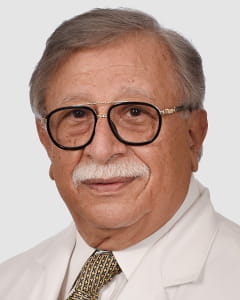As doctors, we always hope for the best outcome but not every surgery always goes according to plan.
Weight loss surgery is no different. Thousands of people undergo this surgery every year, and some of them may gain weight back years later or experience post-surgery complications that we need to address.
In these cases, we must perform a revision or conversion of the first surgery. We typically use minimally invasive techniques to perform a revision, a procedure that corrects the medical issue responsible for the weight gain or complications. A conversion involves using surgery to change one weight loss procedure to another. For example, a person who had lap band surgery may undergo a conversion to gastric bypass or sleeve gastrectomy, or another patient who had a sleeve gastrectomy may undergo a conversion to a duodenal switch or bypass.
These procedures are necessary for two main reasons: weight gain and complications after surgery. People gain weight for different reasons, depending on the procedure. With gastric bypass, weight gain often results from either stretching of the stomach pouch or stretching near the opening of the stoma, which makes the person hungry even an hour or two after eating. With lap band surgery, failure to lose weight could happen because the person is eating the wrong food, which is often caused by a chronic obstruction that occurs when the stomach pouch stretches. Stretching of the stomach pouch, which leads to overeating, also causes weight gain after a sleeve gastrectomy and duodenal switch, but it is rare with the latter procedure.
Unfortunately, complications may happen after surgery. For example, a patient could experience slippage after lap band surgery, erosion of the band in the stomach, obstruction, reflux or stretching of the esophagus. Gastric bypass complications that may require revision include a chronic ulcer that will not heal with medication, persistent low blood sugar and severe malnutrition. With sleeve gastrectomy, we often do a revision after the stomach begins to stretch or the length of the stapled stomach begins to narrow, making it more difficult for food to pass into the digestive system. Malnutrition often is a common cause of revision for duodenal switch procedures. These complications can affect overall health, so it’s important for us to discover the root cause and resolve it.
Revision and conversion procedures come with their own set of risks and the chance of complications is higher compared to first-time weight loss surgeries. Also, different surgeries are more likely to require revisions. The revision rates for weight loss procedures range from 2.7 percent for duodenal switch surgery, to 10-20 percent for gastric bypass, and as high as 50 percent for gastric banding.
If you are considering a revision or conversion, here’s what you need to know about the different procedures:
Gastric Bypass Revision
Roux-en-Y gastric bypass is the most common type of weight loss surgery in the U.S. During this surgery, we use staples to create a small pouch that will hold about one ounce of food at a time, leading you to feel fuller more quickly and eat less food.Roux-en-Y gastric bypass also is a common revision procedure. People who have not met their weight loss goals after gastric banding or stomach stapling may undergo this minimally invasive procedure to lose more weight.
Before you undergo a gastric bypass revision, we’ll need to find the source of your weight gain. We’ll first look carefully at your food consumption to determine if you are following a balanced, healthy diet, If you aren’t, then helping you get back on track will be the first option we pursue rather than surgery.
However, even with a healthy diet and exercise, some people regain weight. Others experience malnutrition because they constantly vomit after eating certain foods. In these situations, revision surgery to restore the original gastric bypass and fix the pouch or stoma may be the best option. Recovery time for this procedure is usually is two weeks.
Another alternative is a conversion procedure to change the gastric bypass to a duodenal switch, a procedure that removes part of the stomach to restrict the amount of calories you consume. This option works best in cases where a complication causes malnutrition or poor eating patterns because someone cannot properly absorb food.
ROSE Procedure
Some people who undergo gastric bypass regain weight as their stomach pouch or the area between the pouch and the small intestine (called the stoma) begins to stretch. When this happens, you don’t feel as full as quickly, which causes overeating and weight gain.The ROSE procedure—Restorative Obesity Surgery Endoscopic—is a non-invasive technique that allows doctors to restore the pouch and stoma to their previous size. The procedure does not require any incisions. We insert a small, flexible instrument through the mouth and into the pouch to create tissue folds that minimize the size of the pouch and the stoma. This incision-less method is beneficial because there is little to no discomfort after the procedure, a lower risk for complications and faster recovery.
StomaphyX Procedure
Like the ROSE Procedure, StomaphyX is a revision procedure for people who have regained weight after gastric bypass surgery. This procedure also addresses weight gain caused by a stretched stomach pouch and stoma. StomaphyX reduces both the pouch and stoma to their size post-gastric bypass. This minimally invasive procedure, which takes up to an hour, involves placing a small medical device (called a StomaphyX) through the mouth and into the stomach. Once the device is inside the stomach pouch, sections of the stomach tissue are suctioned into a small opening in the device, creating tissue folds that are then stitched together to make the pouch smaller. Since the procedure takes minimal time and has a lower risk of complications, we can usually perform it the same day or after an overnight stay. Recovery time is usually a few days.Weight loss after revision or conversion surgery will vary depending on the person. One study showed that people who underwent a conversion from Roux-en-Y gastric bypass to duodenal switch lost 63 percent of their excess weight about one year after surgery. Of course, not everyone will experience this outcome. However, if you have regained weight post-surgery even after following the guidelines set by your doctor and nutritionist, you should talk to your doctor about a revision or conversion procedure. Ongoing complications such as vomiting, ulcers and malnutrition are not normal after surgery and should be addressed as soon as possible to prevent more health issues down the road. The goal of weight loss surgery is to help you maintain a healthy weight long term. But if you don’t achieve this goal after your first surgery and you’ve done everything possible, don’t hesitate to explore other options with your doctor.










